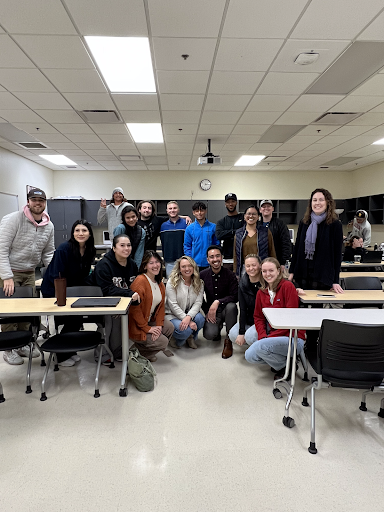Tales from a Hyflex Service-learning Course: The Pros, Cons, and Unknowns
Sonoma State University had planned to start the Spring 2022 semester 70% in person but with the Omicron variant, the face-to-face courses were pushed back three weeks. I have experienced some of the most rewarding experiences of my academic career during this return to some version of “normalcy.” It has also been incredibly challenging in ways that I had not expected. I am going to outline some of the observations I have had over the first semester of being back in a hyflex service-learning course. Hyflex learning is simultaneously teaching students in a face-to-face setting while having some students join from their home setting via an online meeting platform.
I have been teaching a hands-on, experiential, service-learning public relations course during this past semester. The course was planned to be face-to-face, however, once the course started and students had COVID exposures and symptoms, it was clear that we had to pivot to hyflex. Given the nature of this course as a service-learning group-project-based course where students do PR work for a community partner, I was nervous about the hyflex nature of the course. However, it worked out better than I had anticipated with some bumps along the way.
Here are some of my observations from teaching a hyflex service-learning course.
The pros:
-
Students’ overall excitement and happiness to being back in person and having some normalcy
-
Students’ in service-learning courses have the ability to have both virtual and face-to-face meetings with community partners
-
Allowing for service-learning opportunities even without the ability to have site visits
-
Flexibility to meet with the community partner without needing to be in the same space physically
-
Students’ appreciation of being back in the classroom while having the flexibility to join from home when life happens
-
The community built from the in-person collaboration that then bled over to the virtual meetings
-
The vigorous in-class discussion about course-related topics
-
The deep and personal connections with students and colleagues who are more willing to share and be vulnerable than pre-pandemic
The cons:
-
Not knowing who will come to class virtually versus in person can be hard to plan for
-
Community partners were not always able to host students for site visits because of COVID protocols
-
Project groups being mixed in person and virtual caused some disconnect in groups
-
Students seem more distracted in the classroom and have a harder time removing themselves from their screens
-
Some students took advantage of the opportunity to join class virtually and almost never came to class; these were the same students who did not contribute to their group’s projects or participate in class much
-
The varying levels of comfort being in a classroom with so many people-some want masks off, some want masks on, some would prefer being virtual, some are vocal one way or another, etc.
-
People have forgotten some of their interpersonal communication skills-eye contact, small talk, etc.
-
The hesitancy of returning to face-to-face courses and meetings unrelated to COVID/health concerns
The unknowns:
-
What is the impact of a hyflex course on the quality of service the students provide to the community partner?
-
Would it be better to require groups to all be in person or virtual in a given week?
-
Does joining virtually contribute to lack of participation or does lack of participation lead to wanting to join virtually?
-
Will community partners have new and varied needs due to the changes of the pandemic?
-
How can hyflex enhance or hinder service-learning courses?
We have all changed since living through the pandemic and it is no doubt that academia and Sonoma State University will change with it. The questions regarding to what extent, for how long, and how much remain to be seen. Additionally, how will all of this factor into how service-learning courses are taught moving forward? The good news is that we are back together and our willingness to support each other is stronger than it has ever been. We have come back to campus with a new appreciation and a greater empathy for each other, which will carry us forward through whatever changes may arise in service-learning courses moving forward.

Author: Emily Acosta Lewis



